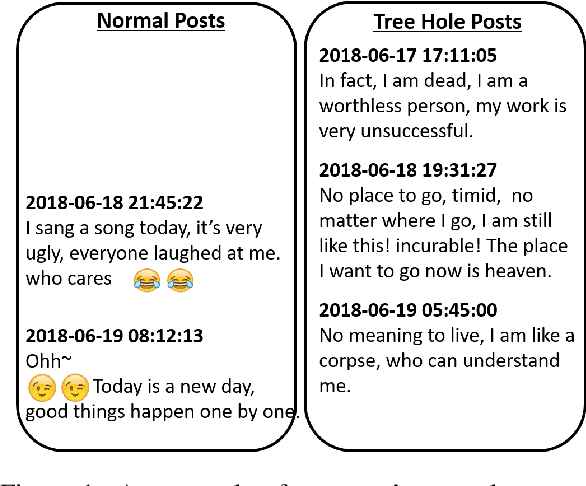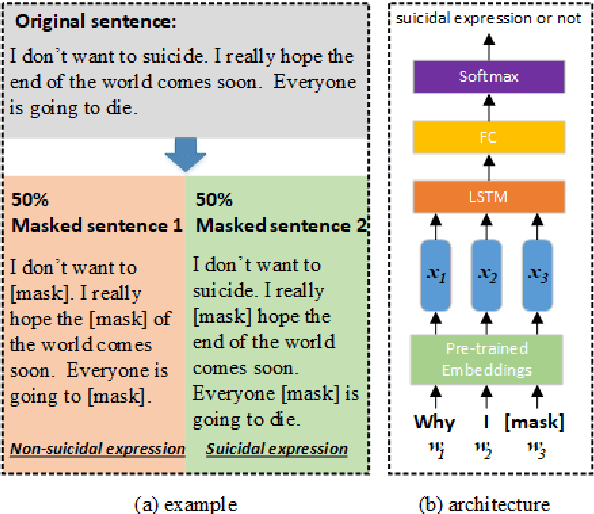Huijun Zhang
MISE: Meta-knowledge Inheritance for Social Media-Based Stressor Estimation
May 03, 2025Abstract:Stress haunts people in modern society, which may cause severe health issues if left unattended. With social media becoming an integral part of daily life, leveraging social media to detect stress has gained increasing attention. While the majority of the work focuses on classifying stress states and stress categories, this study introduce a new task aimed at estimating more specific stressors (like exam, writing paper, etc.) through users' posts on social media. Unfortunately, the diversity of stressors with many different classes but a few examples per class, combined with the consistent arising of new stressors over time, hinders the machine understanding of stressors. To this end, we cast the stressor estimation problem within a practical scenario few-shot learning setting, and propose a novel meta-learning based stressor estimation framework that is enhanced by a meta-knowledge inheritance mechanism. This model can not only learn generic stressor context through meta-learning, but also has a good generalization ability to estimate new stressors with little labeled data. A fundamental breakthrough in our approach lies in the inclusion of the meta-knowledge inheritance mechanism, which equips our model with the ability to prevent catastrophic forgetting when adapting to new stressors. The experimental results show that our model achieves state-of-the-art performance compared with the baselines. Additionally, we construct a social media-based stressor estimation dataset that can help train artificial intelligence models to facilitate human well-being. The dataset is now public at \href{https://www.kaggle.com/datasets/xinwangcs/stressor-cause-of-mental-health-problem-dataset}{\underline{Kaggle}} and \href{https://huggingface.co/datasets/XinWangcs/Stressor}{\underline{Hugging Face}}.
Building and Using Personal Knowledge Graph to Improve Suicidal Ideation Detection on Social Media
Dec 16, 2020



Abstract:A large number of individuals are suffering from suicidal ideation in the world. There are a number of causes behind why an individual might suffer from suicidal ideation. As the most popular platform for self-expression, emotion release, and personal interaction, individuals may exhibit a number of symptoms of suicidal ideation on social media. Nevertheless, challenges from both data and knowledge aspects remain as obstacles, constraining the social media-based detection performance. Data implicitness and sparsity make it difficult to discover the inner true intentions of individuals based on their posts. Inspired by psychological studies, we build and unify a high-level suicide-oriented knowledge graph with deep neural networks for suicidal ideation detection on social media. We further design a two-layered attention mechanism to explicitly reason and establish key risk factors to individual's suicidal ideation. The performance study on microblog and Reddit shows that: 1) with the constructed personal knowledge graph, the social media-based suicidal ideation detection can achieve over 93% accuracy; and 2) among the six categories of personal factors, post, personality, and experience are the top-3 key indicators. Under these categories, posted text, stress level, stress duration, posted image, and ruminant thinking contribute to one's suicidal ideation detection.
Latent Suicide Risk Detection on Microblog via Suicide-Oriented Word Embeddings and Layered Attention
Oct 26, 2019



Abstract:Despite detection of suicidal ideation on social media has made great progress in recent years, people's implicitly and anti-real contrarily expressed posts still remain as an obstacle, constraining the detectors to acquire higher satisfactory performance. Enlightened by the hidden "tree holes" phenomenon on microblog, where people at suicide risk tend to disclose their inner real feelings and thoughts to the microblog space whose authors have committed suicide, we explore the use of tree holes to enhance microblog-based suicide risk detection from the following two perspectives. (1) We build suicide-oriented word embeddings based on tree hole contents to strength the sensibility of suicide-related lexicons and context based on tree hole contents. (2) A two-layered attention mechanism is deployed to grasp intermittently changing points from individual's open blog streams, revealing one's inner emotional world more or less. Our experimental results show that with suicide-oriented word embeddings and attention, microblog-based suicide risk detection can achieve over 91\% accuracy. A large-scale well-labelled suicide data set is also reported in the paper.
 Add to Chrome
Add to Chrome Add to Firefox
Add to Firefox Add to Edge
Add to Edge